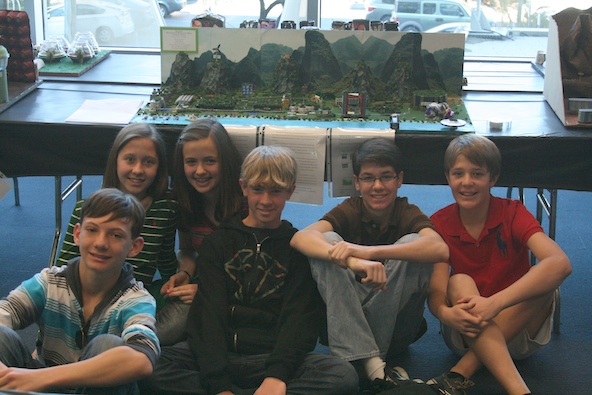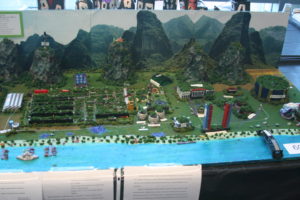
The Gospel says that faith can move mountains. It didn’t say anything about building them, except for when God spoke them into creation.
Learning how to make scaled mountains — as a panoramic backdrop using photography and a 3-D model — was only the beginning of the laundry list of things a group of seventh-graders learned after agreeing to enter the Arizona Future City contest. It’s part of the national competition, which is sponsored by National Engineers Week each February.
The idea is to encourage junior high students to engage in science, technology, engineering and math concepts. A record 115 teams are competing at the state level this year topping the typical 92 or 93 since its inception 16 years ago. This time around, Scottsdale’s Our Lady of Perpetual Help students are the only ones from a diocesan Catholic school.
All models and their accompanying essays are on display through Jan. 25 at the Burton Barr Central Library in Phoenix. Public voting to select the best model — OLPH’s is No. 603 — ends Friday with privately judged presentations scheduled for Saturday.
Each project visually displays and details in a maximum 1,000-word essay their vision of tomorrow’s urban world. This year, students proposed a clean solution to address runoff by managing storm water pollution.


The city, all built on two circuit boards, also features a monorail system, a wind and water turbine plus a steam-based not fossil-fuel-based industrial park. Just like today, major facilities and subdivisions in their city of the future are named after the founders and their ancestors.
“I thought it’d be fun to challenge ourselves to think about the future and not spend a lot of money,” Andrew Nahom said.
Each group must itemize their expenses, which can’t exceed $100. The OLPH group estimated they spent about a quarter of that, mostly on photo developing and enlarging to enhance the backdrop.
“You’ll never look at a piece of trash the same,” admitted Kate Straneva.
She said each teammate brought in two large trash bags full of items to consider recycling for the project. They based their city around two circuit boards, sculpted paper cups for public art, melted other kitchenware for the wind and water turbine and used glitter, paint, greenery and items on hand from their teacher’s junk drawer.
“The possibilities are endless on what you can create,” Straneva said.
Nahom, one of four male teammates, deemed it a “no pressure project that we could have fun with.”
They had four months of fun working weekly after school. In the last two months or so, they also met Friday afternoons and often during lunch. Some focused on the city narrative, others on the speech and they all pitched in on the model.
They also managed a municipal design using SimCity 4 software. That challenged them to manipulate the government, manage protests, and invest in sectors like education and healthcare to keep stakeholders happy
“It was hard to control the dirty industry because you want to have low regulation, but you also want to have a clean environment,” Nahom said. “God made this planet, so we should make sure it’s clean.”
Straneva said projects like this have their benefit not only for the teamwork element, but to begin thinking concretely about life down the road.
“We are the future,” she said quite simply.
Deborah Magish, the student’s project adviser and science teacher, always offers it to seventh-graders. She said they learn engineering concepts that she’s not afforded the luxury of teaching in class (see all enrichment programs). Better yet, Magish said, the knowledge gets put into a comprehensive plan.
It has also opened doors for her students over the years. It developed a self-confidence in most and honed teamwork cooperation skills for all, especially for a student with disabilities one year. He delivered his presentation dress in character as a college professor. Some of Magish’s former students are engineers or studying it in college.
“It changed them and gave them goals that they never would have been exposed to,” Magish said.
“They begin to learn at this age they’re part of a city,” she said, noting that they also come to master the term and concept of “infrastructure.”
And many have been award-winning cities. They came close to top prize several times. Others have earned third and fourth pace finishes. Three teams have entered a separate “special competition” charged with creating a future school or transit system and took first place each time.
Part of it is reading the rules, Magish said, “but there’s still a great deal of creativity and a great deal of hard work.”





